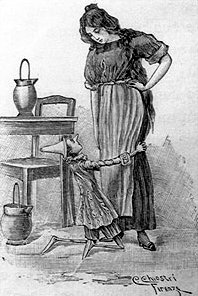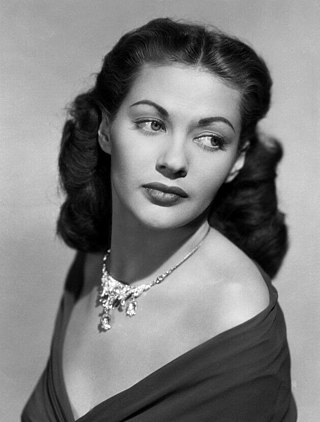
Shirley Mae Jones is an American actress and singer. In her six decades in show business, she has starred as wholesome characters in a number of musical films, such as Oklahoma! (1955), Carousel (1956), and The Music Man (1962). She won the Academy Award for Best Supporting Actress for playing a vengeful prostitute in Elmer Gantry (1960). She played the lead role of Shirley Partridge, the widowed mother of five children, in the musical situation-comedy television series The Partridge Family (1970–1974), which co-starred her real-life stepson, David Cassidy, son of Jack Cassidy.

Salome, also known as Salome III, was a Jewish princess, the daughter of Herod II and princess Herodias. She was granddaughter of Herod the Great and stepdaughter of Herod Antipas. She is known from the New Testament, where she is not named, and from an account by Josephus. In the New Testament, the stepdaughter of Herod Antipas demands and receives the head of John the Baptist. According to Josephus, she was first married to her uncle Philip the Tetrarch, after whose death in AD 34 she married her cousin Aristobulus of Chalcis, thus becoming queen of Armenia Minor.

Herodias was a princess of the Herodian dynasty of Judaea during the time of the Roman Empire. Christian writings connect her with the execution of John the Baptist.

A femme fatale, sometimes called a maneater, Mata Hari, or vamp, is a stock character of a mysterious, beautiful, and seductive woman whose charms ensnare her lovers, often leading them into compromising, deadly traps. She is an archetype of literature and art. Her ability to enchant, entice and hypnotize her victim with a spell was in the earliest stories seen as verging on supernatural; hence, the femme fatale today is still often described as having a power akin to an enchantress, seductress, witch, having power over men. Femmes fatales are typically villainous, or at least morally ambiguous, and always associated with a sense of mystification, and unease.

Laura Elizabeth Metcalf is an American actress and comedian. Known for her complex and versatile roles across the stage and screen, she has received various accolades throughout her career spanning more than four decades, including four Primetime Emmy Awards and two Tony Awards, in addition to nominations for an Academy Award, a BAFTA Award, and three Golden Globe Awards.

The Fairy with Turquoise Hair, often simply referred to as the Blue Fairy, is a fictional character in the 1883 Italian book The Adventures of Pinocchio by Carlo Collodi, repeatedly appearing at critical moments in Pinocchio's wanderings to admonish the little wooden puppet to avoid bad or risky behavior.

Herod Antipas was a 1st-century ruler of Galilee and Perea. He bore the title of tetrarch and is referred to as both "Herod the Tetrarch" and "King Herod" in the New Testament. He was a son of Herod the Great and a grandson of Antipater the Idumaean. He is widely known today for accounts in the New Testament of his role in events that led to the executions of John the Baptist and Jesus of Nazareth. His father, Herod the Great, was described in the account as ordering the Massacre of the Innocents, marking the earliest Biblical account of the concerns of the government in Jerusalem regarding Jesus' existence.

Francis William Thring IV was an Australian character actor in radio, stage, television and film; as well as a theatre director. His early career started in London in theatre productions, before he starred in Hollywood film, where he became best known for roles in Ben-Hur in 1959 and King of Kings in 1961. He was known for always wearing black and styling his home in black decor.

Margaret Yvonne Middleton, known professionally as Yvonne De Carlo, was a Canadian-American actress, dancer and singer. She became a Hollywood film star in the 1940s and 1950s, made several recordings, and later acted on television and stage.

Salome, Op. 54, is an opera in one act by Richard Strauss. The libretto is Hedwig Lachmann's German translation of the 1891 French play Salomé by Oscar Wilde, edited by the composer. Strauss dedicated the opera to his friend Sir Edgar Speyer.

Joseph Schildkraut was an Austrian-American actor. He won an Oscar for his performance as Captain Alfred Dreyfus in the film The Life of Emile Zola (1937). He was nominated for a Golden Globe for his performance as Otto Frank in the film The Diary of Anne Frank (1959) and a Primetime Emmy for his performance as Rabbi Gottlieb in a 1962 episode of the television series Sam Benedict.

Salome is a one-act tragedy by Oscar Wilde. The original version of the play was first published in French in 1893; an English translation was published a year later. The play depicts the attempted seduction of Jokanaan by Salome, stepdaughter of Herod Antipas; her dance of the seven veils; the execution of Jokanaan at Salome's instigation; and her death on Herod's orders.

The Dance of the Seven Veils is the dance performed by Salome before King Herod Antipas in modern stage, literature, and visual arts. It is an elaboration on the New Testament story of the Feast of Herod and the execution of John the Baptist, which refers to Salome dancing before the king, but does not give the dance a name.

King of Kings is a 1961 American epic religious film directed by Nicholas Ray and produced by Samuel Bronston for Metro-Goldwyn-Mayer. Adapted from the New Testament, the film tells the story of Jesus of Nazareth from his birth and ministry to his crucifixion and resurrection. It stars Jeffrey Hunter as Jesus, with Siobhán McKenna, Robert Ryan, Viveca Lindfors, Ron Randell, Hurd Hatfield, and Rip Torn and is narrated by Orson Welles.

Sally Ann Howes was an English actress and singer. Her career on screen, stage and television spanned six decades. She is best known for the role of Truly Scrumptious in the 1968 musical film Chitty Chitty Bang Bang. In 1963, she was nominated for a Tony Award for Best Lead Actress in a Musical for her performance in Brigadoon.

The Honeymoon Machine is a 1961 American comedy film directed by Richard Thorpe and starring Steve McQueen, Brigid Bazlen, Jim Hutton, Paula Prentiss, Jack Mullaney and Dean Jagger, based on the 1959 Broadway play The Golden Fleecing by Lorenzo Semple Jr. In the film, three men devise a plan to win at roulette with a United States Navy computer. The scheme works until an admiral ruins their plans.

Hawkins Falls, Population 6200 is an American television soap opera that was broadcast in the 1950s, live from Chicago. Though it was not the first original (non-radio-derived) soap opera on American TV, it was the first to be successful, running for more than five years.

Salome's Last Dance is a 1988 British film written and directed by Ken Russell. Although most of the action is a verbatim performance of Oscar Wilde's 1891 play Salome, which is itself based on a story from the New Testament, there is also a framing narrative that was written by Russell.

Salome is a 1953 American drama Biblical film directed by William Dieterle and produced by Buddy Adler from a screenplay by Harry Kleiner and Jesse Lasky Jr. The music score was by George Duning, the dance music by Daniele Amfitheatrof and the cinematography by Charles Lang. Rita Hayworth's costumes were designed by Jean Louis. Hayworth's dances for this film were choreographed by Valerie Bettis. This film was the last produced by Hayworth's production company, the Beckworth Corporation.

Salomé is a 2002 Spanish film directed by Carlos Saura. The film is told from the perspective of a flamenco dance company that will mount a show devoted to the mythical and biblical figure of Salomé, as a story of love and vengeance. The movie is both about the performance and the preparation for it.

![Bazlen portrays Salome, seen here performing an erotic dance in order to incite King Herod with lust into giving her "anything [she] wants" - in other words, the head of John the Baptist. Salome dancing.jpg](http://upload.wikimedia.org/wikipedia/en/thumb/2/24/Salome_dancing.jpg/300px-Salome_dancing.jpg)


















